Jobs for Filipinos: Dark past and present, uncertain future

Image: Daniella Marie Agacer
MANILA, Philippines — Current and past employment pictures are easy to draw but what about their future under any one in the current crop of presidential candidates?
In December 2021, while more COVID restrictions were eased which would mean more businesses coming back to life, the jobless rate went up from 6.5 to 6.6 percent.
But, according to the Philippine Statistics Authority (PSA) which released the employment data on Thursday (Feb. 10), the reason was simply because of an increase in Labor Force Participation Rate (LFPR), which meant more people entered the workforce.
READ: PSA: Number of unemployed Filipinos rises to 3.27 million in Dec. 2021
LFPR was just 64.2 percent in November but 65 percent in December, according to the PSA.
National Statistician Dennis Mapa said the labor force was 49.55 million from just 48.64 million in November and 47.33 million in October.
Unemployment in December translated to 3.27 million individuals without jobs, higher than 3.16 million in November but lower than 3.50 million in October, when most of the Philippines was on COVID Alert Level 3.
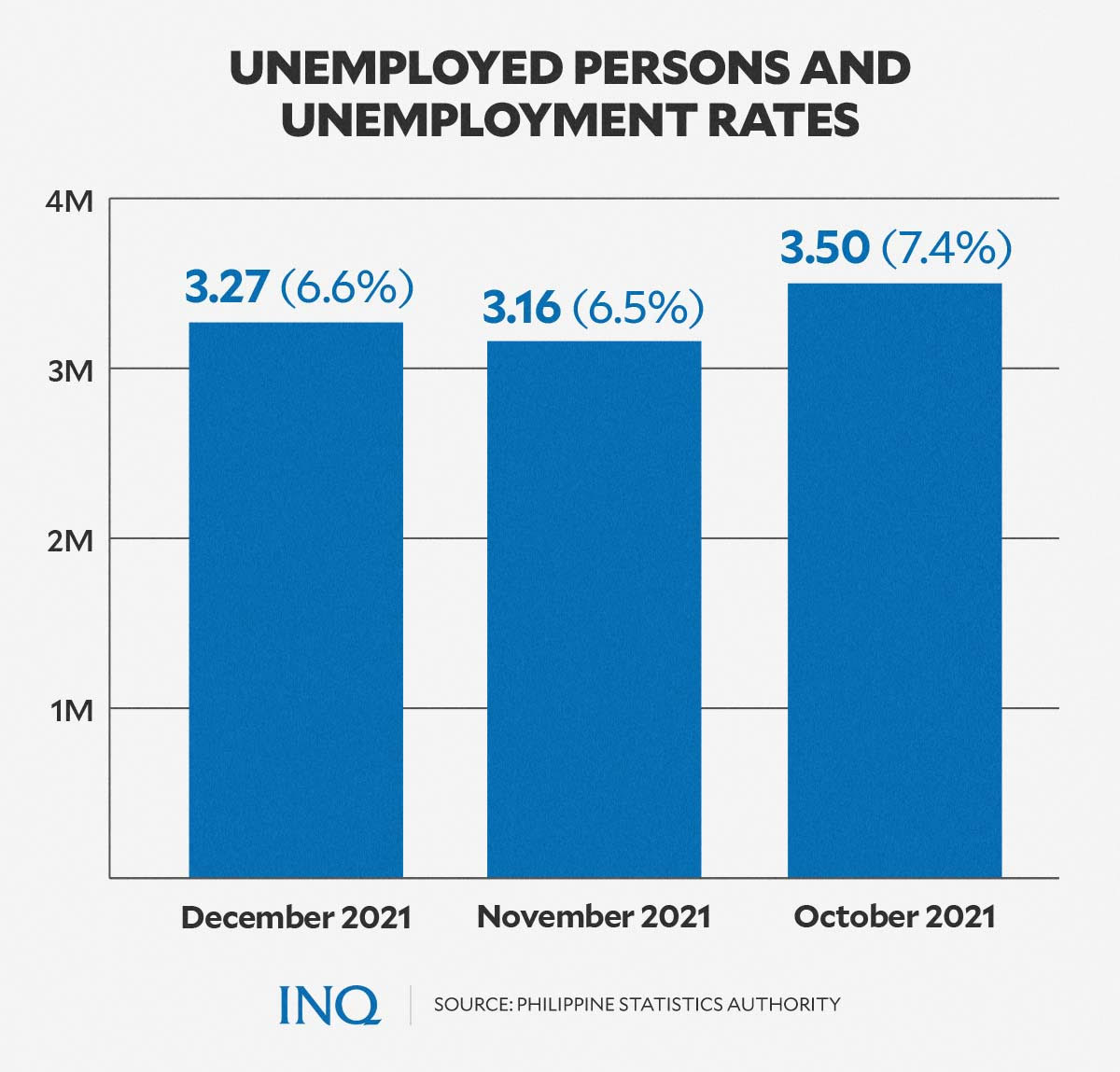
Graphic: Ed Lustan
“Not everyone who took part was able to get a job. While most of them were employed, some were not,” said Mapa.
“If we take a look, the rate is not significantly different, however, there’s still a slight increase,” he said.
The 0.9 LFPR difference translated to 910,000 individuals––800,000 were employed while the rest, or 110,000, were not able to get a job, Mapa said, stressing that he also saw an increase in new workers between the ages of 25 and 34.
He said the increase in LFPR was caused by the relaxation of COVID restrictions in December, when most of the Philippines was already on less stricter Alert Levels 1 and 2.
Mapa, who is also the Civil Registrar General, said the Christmas and New Year celebrations, which seeded “seasonal work”, likewise contributed to the increase in LFPR.
December’s employment rate had a slight decline––from 93.5 percent or 45.48 million in November to 93.4 percent or 46.27 million. However, the employment rate was higher compared to the 92.6 or 43.83 million in October.
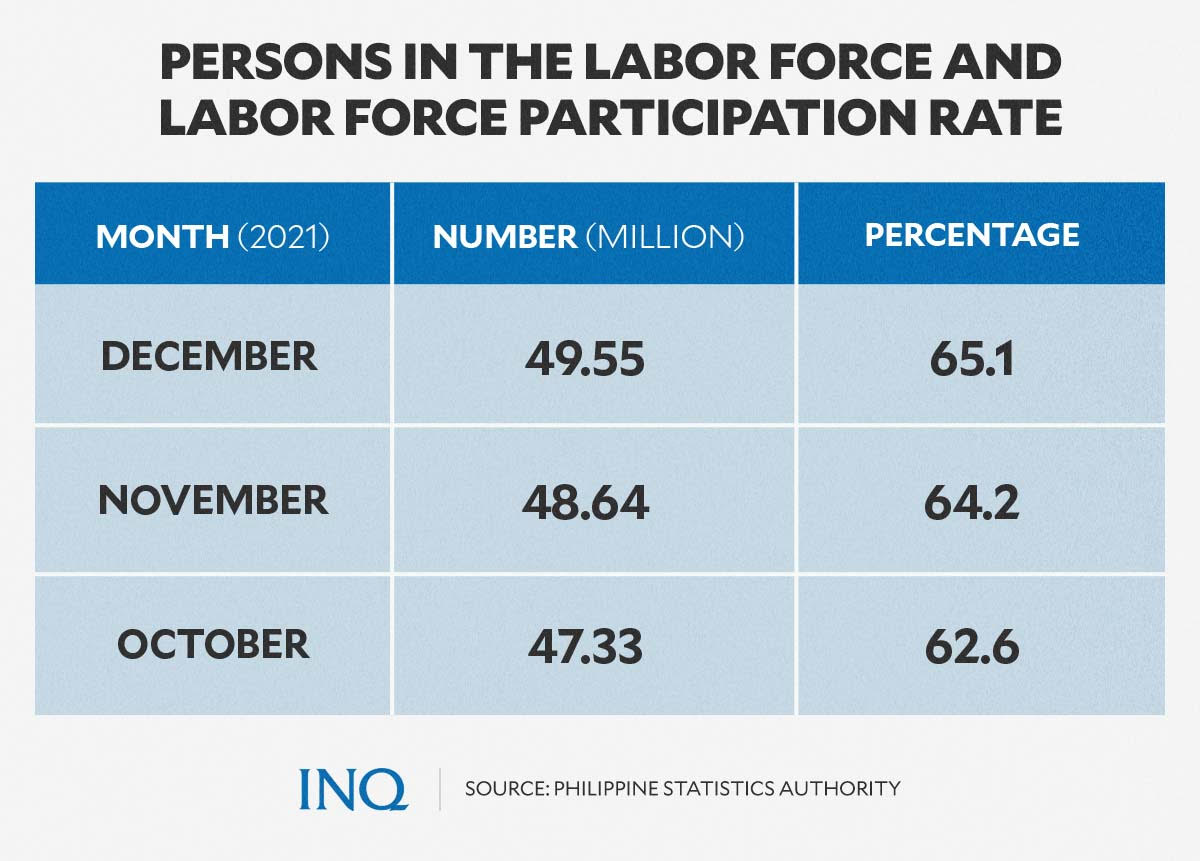
Graphic: Ed Lustan
The PSA said the 14.7 percent underemployment rate which translates to 6.81 million individuals was lower compared to the 16.7 percent or 7.62 million in November and 16.1 percent or 7.04 million in October.
Mapa explained that there was a significant drop in underemployment because a lot of industries already started operating for 40 hours or more. The top three industries were agriculture and forestry, wholesale and retail trade, and public administration and defense.
Context of elections
While the rise and fall of employment could be easily explained with the significant increase in LFPR, Ibon Foundation’s Rosario Guzman said “we are seeing the worst conditions in the labor front at this point.”
Guzman, who heads the research department of Ibon Foundation, told INQUIRER.net that the 2016 to 2021 unemployment increase of 1.3 million was the “biggest in all post–Marcos administrations”.
She said President Rodrigo Duterte’s administration also had the “least jobs created and least frequent and smallest amount of wage hikes,” stressing that real wage increases fell during his tenure.
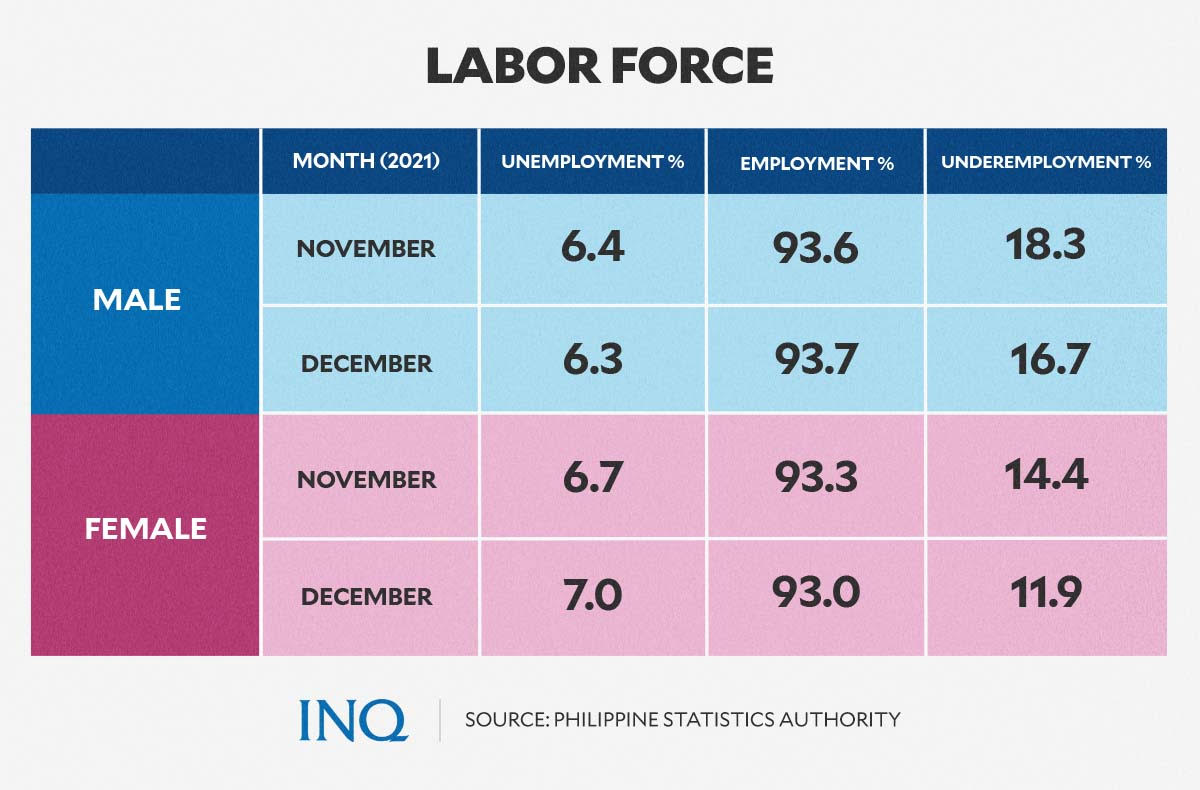
Graphic: Ed Lustan
Ibon Foundation stressed that the administration had the “worst job generation” record since 1986 with a yearly average of 313,000 jobs created in 2017 to 2019 and an average of 2.6 million jobs lost in 2020, the year COVID-19 hit.
“That is the context of the 2022 elections,” she said, saying that an individual seeking the presidency “who ignores this enormity of the crisis is unthinking if not insincere.”
“The presidential candidates will have to fix the economic scarring from the protracted lockdowns and strengthen the productive sectors of the economy,” Guzman said.
She said plans will have to be directed at making the decisive shift from simply being a service economy towards a production-oriented one, creating new values and a complete range of commodities for domestic needs.
Guzman stressed that no presidential candidate can seriously talk about addressing the jobs crisis that the Duterte government is leaving behind––a crisis marked by the highest increase in joblessness and worsening underemployment.
RELATED STORY: Promises: 5 presidential aspirants present plans for PH
She said candidates should talk about agriculture development and the national industrialization plan because, otherwise, “they may just be mouthing empty promises of creating jobs, which are not regular, permanent and meaningful.”
Promises to address the crisis
- Leody de Guzman
De Guzman said last year that there should be an “aggressive” creation of jobs to address the rise in joblessness, stressing that it is the government’s responsibility to solve the crisis and, “not maintaining or facilitating the profits of billionaires.”
Last Jan. 21, he said at the Pandesal Forum that to generate more jobs, working hours should be cut from eight to six hours as the Philippines is still in an economic slowdown because of the COVID-19 crisis.
He said the two hours that will be made available will pave the way for the hiring of 11 million more workers. He, however, said that this should not become a reason to reduce salaries and benefits of employees.
De Guzman also promised to back micro, small and medium enterprises (MSMEs) to hire more workers and provide more jobs, especially for people who are not employed because of the COVID-19 crisis.
- Panfilo Lacson
Should he win, Lacson said last year that his first 100 days will provide a more efficient lifeline to the health and economic sectors in the Philippines.
Lacson said there’s a need to prioritize the creation of emergency employment programs and food terminals in each region to address joblessness.
He explained the emergency employment program will provide government internships for “graduates and undergraduates” while the government can tap the private sector to take those with higher qualifications.
This, Lacson said, will also give the public and private agencies the opportunities to harness the skills of the youth, both graduates and undergraduates.
- Ferdinand Marcos Jr.
Marcos Jr. told SMNI News on Jan. 16 that to hasten economic recovery, he will create more jobs with a focus on business, agriculture, tourism and infrastructure industries in line with the “Build, Build, Build” program of the government which he said was “successful”.
He said the “critical element” in economic recovery is bringing back Filipinos to work, highlighting one of his top priorities––MSMEs––as they can quickly create work for Filipinos and help them feed their families.
A week later, Marcos Jr. told ALC Media that he will propose a retraining program for returning OFWs to equip them with skills for the international labor market.
RELATED STORY: Dep’t of Migrant Workers ‘excellent solution’ to help OFWs – Marcos Jr.
- Isko Moreno
Moreno said his top priority is to create new jobs for people who are not employed and that he will eventually address the regularization of contractual workers once the economy has recovered from the COVID-19 crisis.
READ: Creation of new jobs top priority under an Isko Moreno presidency
He said his administration will help revive MSMEs which were severely hit by the crisis. Training activities, workshops and other programs will also be given to OFWs to help them find better opportunities.
Moreno said at the Kapisanan ng mga Brodkaster ng Pilipinas’ (KBP) Forum on Feb. 4 that he will initiate a mission with the Department of Trade and Industry, Department of Science and Technology, and Department of Information and Communications Technology to back MSMEs to upgrade their business models and increase the loan pool to P30 billion.
- Manny Pacquiao
As livelihood, Pacquaio said at the KBP Forum on Feb. 4, is essential in promoting the “health of the nation,” he promised to prioritize Filipinos for employment should he win the elections on May 9.
He said since there’s a need to strengthen economic recovery, it’s important to assert the rights of Filipinos as the Constitution states that the government should promote the preferential use of Filipino labor and help make them competitive.
Section 12, Article XII of the Constitution provides: “The State shall promote the preferential use of Filipino labor, domestic materials and locally produced goods, and adopt measures that help make them competitive.”
Pacquiao said he will impose the “Filipino first” policy while seeking a “more favorable and welcoming climate” for foreign investors.
“Our economy is not at its best situation that is why we cannot generate jobs. A lot of small businesses which provide jobs to our people have also closed down. What we need to do is strengthen our economy,” he said.
- Leni Robredo
As Robredo revealed her five-point “Hanapbuhay Para sa Lahat,” she identified budget sources that were initially worth P192 billion.
READ: Robredo’s labor agenda seeks to help local industries, MSMEs
Her program, she said, will take-off from bringing back trust in the government; strengthening industries in the Philippines; ending work discrimination; backing small-scale industries; and assisting those who don’t have work.
These, as she likewise plans to introduce a program which will “retrain and match the skills” of workers. She said she wants to create a Public Employment Program for two million Filipinos and an Unemployment Insurance Program to help displaced workers.
She said she will also protect the welfare of OFWs by entering into bilateral agreements with countries that host OFWs and to strengthen their skills so they won’t be “underemployed” overseas.
Things to know
The PSA said the proportion of those working less than 40 hours in a week and wanted to work for more hours was 9.8 percent in December 2021, lower than 11.5 percent In November.
Those working for 40 hours in a week but wanted more work hours in their present jobs was 4.9 percent in December 2021, lower than 5.2 percent in November 2021.
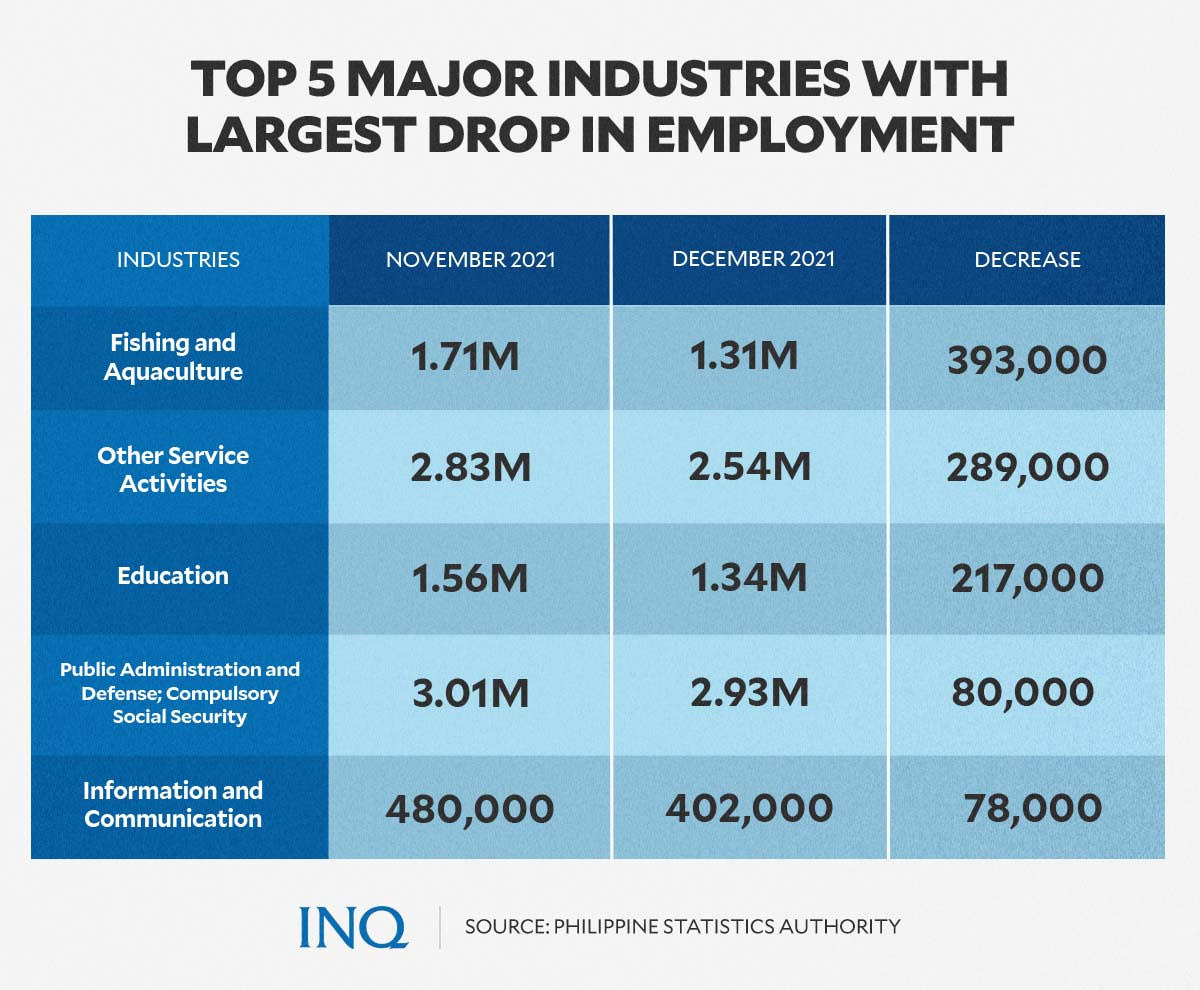
Graphic: Ed Lustan
The PSA said the services sector consistently had the largest share of underemployment contributing 46.7 percent of the 6.81 million total “underemployed” persons; agriculture sector, 33.3 percent; and industry sector, 19.9 percent.
The average weekly work hours of an employed person in December 2021 was 39.7 hours per week. In November 2021, it was lower at 39.6 hours per week.

Graphic: Ed Lustan
For the broad industry group, the services sector consistently remained the dominant in employment, absorbing 56.6 percent or 26.21 million employed individuals; agriculture and the industry sectors employed 25.6 percent or 11.83 million and 17.8 percent or 8.24 million, respectively.
Here’s a glimpse of the top five industries with a rise in employed persons:
- Agriculture and Forestry
November: 9.45 million
December: 10.52 million
- Manufacturing
November: 3.37 million
December: 3.69 million
- Human Health and Social Work Activities
November: 643,000
December: 808,000
- Transportation and Storage
November: 2.86 million
December: 3.00 million
- Administrative and Support Service Activities
November: 1.93 million
December: 2.06 million
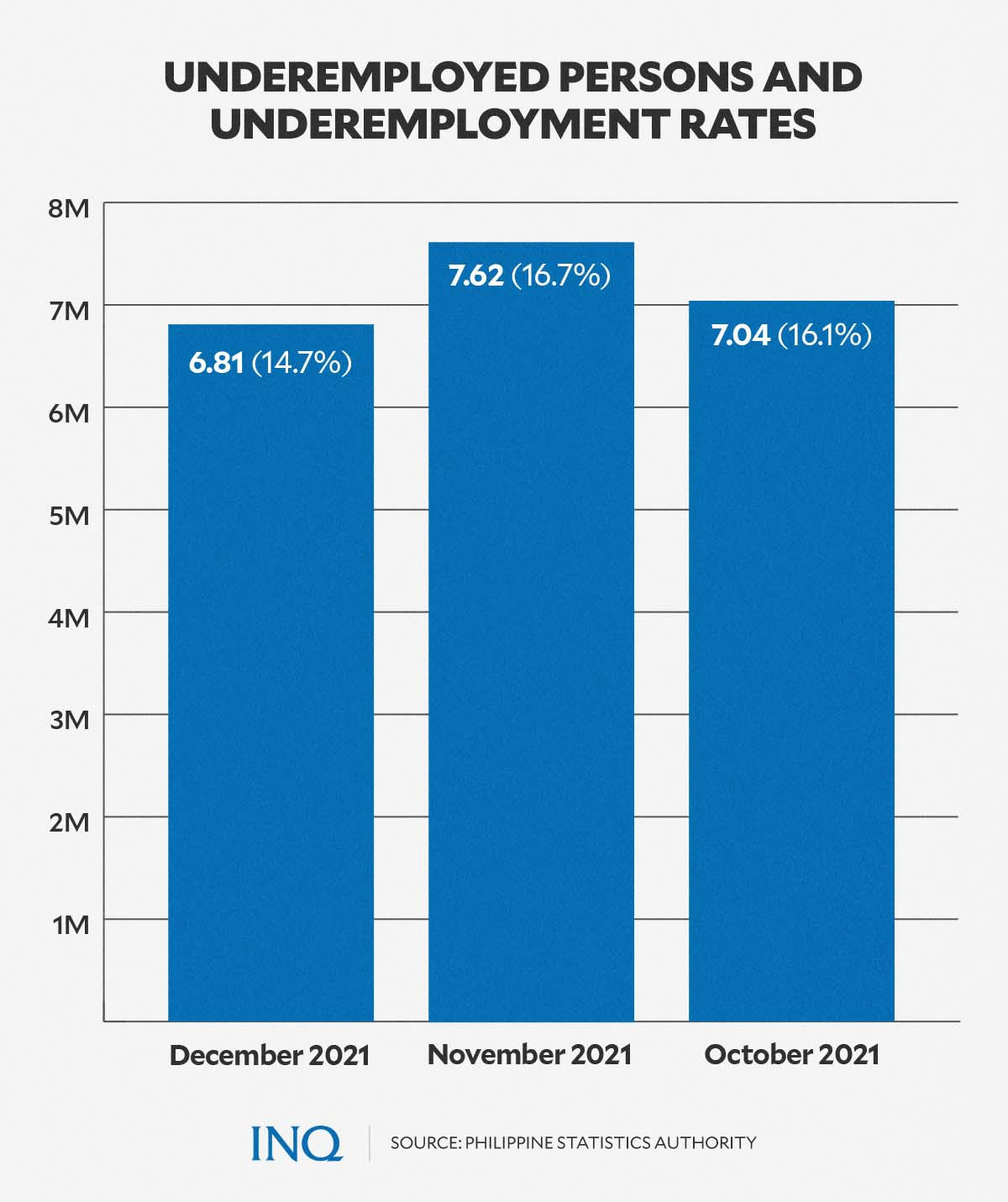
Graphic: Ed Lustan
Here’s a glimpse of the top five industries that shed employment:
- Fishing and aquaculture
November: 1.71 million
December: 1.31 million
- Other Service Activities
November: 2.83 million
December: 2.54 million
- Education
November: 1.56 million
December: 1.34 million
- Public Administration and Defense; Compulsory Social Security
November: 3.01 million
December: 2.93 million
- Information and Communication
November: 480,000
December: 402,000
The PSA said joblessness was high among females (7.0 percent) compared to males (6.3 percent) while employment was higher among males (93.7 percent) than females (93.0 percent) and underemployment was higher among males (16.7 percent) compared to females (11.9 percent).
RELATED STORIES:
Paradox of our time: More jobs lost as COVID cases, PH restrictions ease
New lockdown shuts employment door for displaced workers
TSB
For more news about the novel coronavirus click here.
What you need to know about Coronavirus.
For more information on COVID-19, call the DOH Hotline: (02) 86517800 local 1149/1150.
The Inquirer Foundation supports our healthcare frontliners and is still accepting cash donations to be deposited at Banco de Oro (BDO) current account #007960018860 or donate through PayMaya using this link.